初中现在进行时和过去进行时知识点和题精心总结
初中时态理解知识点总结
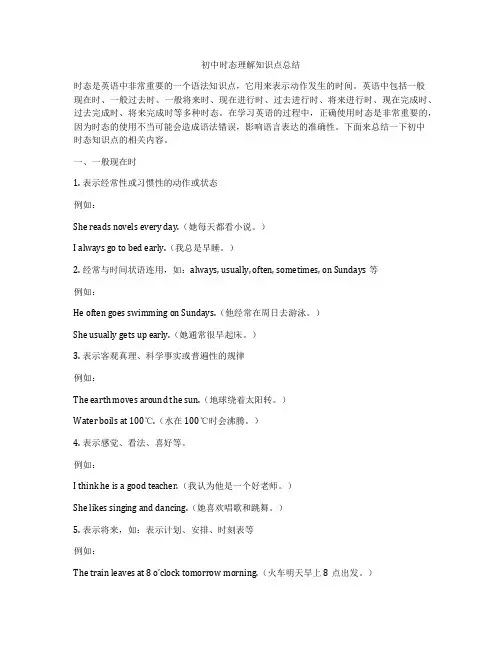
初中时态理解知识点总结时态是英语中非常重要的一个语法知识点,它用来表示动作发生的时间。
英语中包括一般现在时、一般过去时、一般将来时、现在进行时、过去进行时、将来进行时、现在完成时、过去完成时、将来完成时等多种时态。
在学习英语的过程中,正确使用时态是非常重要的,因为时态的使用不当可能会造成语法错误,影响语言表达的准确性。
下面来总结一下初中时态知识点的相关内容。
一、一般现在时1. 表示经常性或习惯性的动作或状态例如:She reads novels every day.(她每天都看小说。
)I always go to bed early.(我总是早睡。
)2. 经常与时间状语连用,如:always, usually, often, sometimes, on Sundays等例如:He often goes swimming on Sundays.(他经常在周日去游泳。
)She usually gets up early.(她通常很早起床。
)3. 表示客观真理、科学事实或普遍性的规律例如:The earth moves around the sun.(地球绕着太阳转。
)Water boils at 100℃.(水在100℃时会沸腾。
)4. 表示感觉、看法、喜好等。
例如:I think he is a good teacher.(我认为他是一个好老师。
)She likes singing and dancing.(她喜欢唱歌和跳舞。
)5. 表示将来,如:表示计划、安排、时刻表等例如:The train leaves at 8 o’clock tomorrow morning.(火车明天早上8点出发。
)We have a meeting next Monday.(我们下周一开会。
)二、一般过去时1. 表示过去某个时间发生的动作或状态例如:She studied English last night.(她昨晚学英语了。
九年级英语时态知识点总结
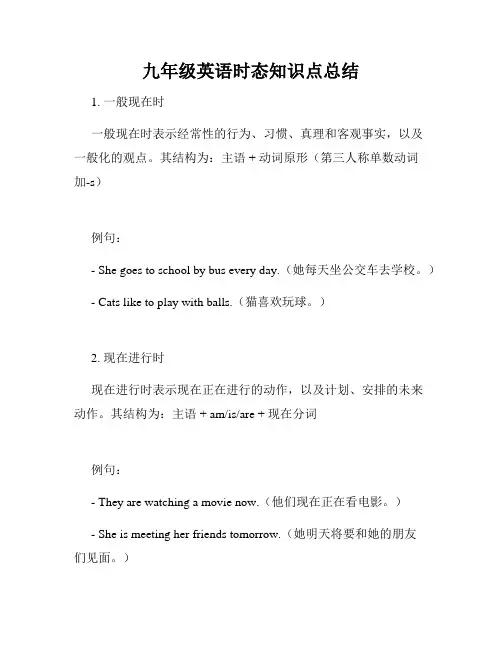
九年级英语时态知识点总结1. 一般现在时一般现在时表示经常性的行为、习惯、真理和客观事实,以及一般化的观点。
其结构为:主语 + 动词原形(第三人称单数动词加-s)例句:- She goes to school by bus every day.(她每天坐公交车去学校。
)- Cats like to play with balls.(猫喜欢玩球。
)2. 现在进行时现在进行时表示现在正在进行的动作,以及计划、安排的未来动作。
其结构为:主语 + am/is/are + 现在分词例句:- They are watching a movie now.(他们现在正在看电影。
)- She is meeting her friends tomorrow.(她明天将要和她的朋友们见面。
)3. 一般过去时一般过去时表示过去发生的动作或状态。
其结构为:主语 + 动词过去式例句:- We went to the beach last summer.(我们去年夏天去了海滩。
)- He studied hard for the test.(他为了考试努力学习。
)4. 过去进行时过去进行时表示过去某个时间段正在进行的动作。
其结构为:主语 + was/were + 现在分词例句:- They were playing soccer when it started raining.(下雨时他们正在踢足球。
)- I was studying in the library yesterday afternoon.(昨天下午我在图书馆学习。
)5. 一般将来时一般将来时表示将来某个时间要发生的动作。
其结构为:主语+ will + 动词原形例句:- We will have a party next week.(我们下周要开派对。
)- She will visit her grandparents this weekend.(她这个周末要去看望她的祖父母。
现在进行时与过去进行时完整小结复习
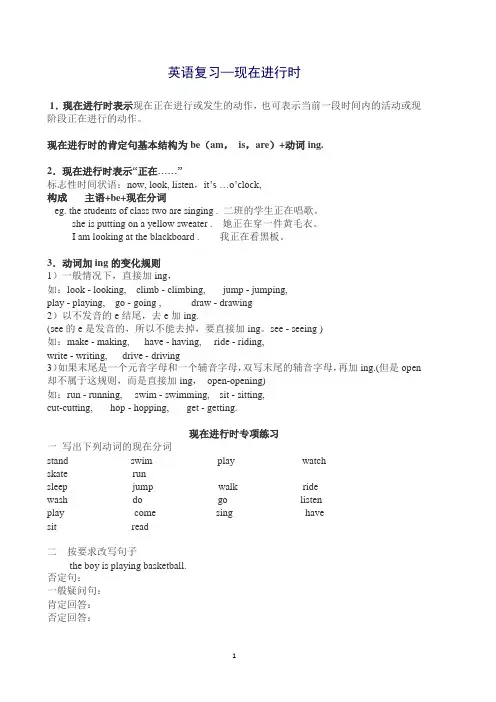
英语复习—现在进行时1.现在进行时表示现在正在进行或发生的动作,也可表示当前一段时间内的活动或现阶段正在进行的动作。
现在进行时的肯定句基本结构为be(am,is,are)+动词ing.2.现在进行时表示“正在……”标志性时间状语:now, look, listen,it’s …o’clock,构成主语+be+现在分词eg. the students of class two are singing . 二班的学生正在唱歌。
she is putting on a yellow sweater . 她正在穿一件黄毛衣。
I am looking at the blackboard . 我正在看黑板。
3.动词加ing的变化规则1)一般情况下,直接加ing,如:look - looking, climb - climbing, jump - jumping,play - playing, go - going , draw - drawing2)以不发音的e结尾,去e加ing.(see的e是发音的,所以不能去掉,要直接加ing。
see - seeing )如:make - making, have - having, ride - riding,write - writing, drive - driving3)如果末尾是一个元音字母和一个辅音字母,双写末尾的辅音字母,再加ing.(但是open 却不属于这规则,而是直接加ing,open-opening)如:run - running, swim - swimming, sit - sitting,cut-cutting, hop - hopping, get - getting.现在进行时专项练习一写出下列动词的现在分词stand_________ swim_________ play__________ watch________skate _________ run__________sleep_________ jump_________ walk_________ ride__________wash_________ do____________ go__________ listen_________play __________ come_________ sing__________ have_________sit___________ read_________二按要求改写句子the boy is playing basketball.否定句:____________________________一般疑问句:_________________________肯定回答:__________________________否定回答:__________________________三用括号中动词的适当形式填空:1. my parents _______ (watch)tv now.2. look. three boys _______ (run).3. what _______ your mother _______ (do)now?4. _______ your dog _______ now?(sleep)5. _______ you _______(listen)to music? yes, i am.6. look, miss chen _______ football.(play)7. tom and his sister _______ (wait)for you over there.8. now class 3 and class 4 _______ (have)a test.9. listen, someone _______ (sing)in the classroom.10. ——where is zhang yan?——she _______ (talk)with her teacher in the teacher’s office.四选择填空:()1. who ______ over there now?a. singingb. are singc. is singing( 2. it’s nine ten. the students ______ a music class.a. haveb. havingc. are having()3. listen! the boy________a. cryingb. is cryingc. cries()4. don’t talk here. grandparents ______.a. sleepb. is sleepingc. are sleeping()5. is the man _______ tea or milk?a. drinksb. drinkc. drinking五根据中文提示完成句子:1. 小花不是在写作业,她在画画。
初中英语时态知识点总结人教版
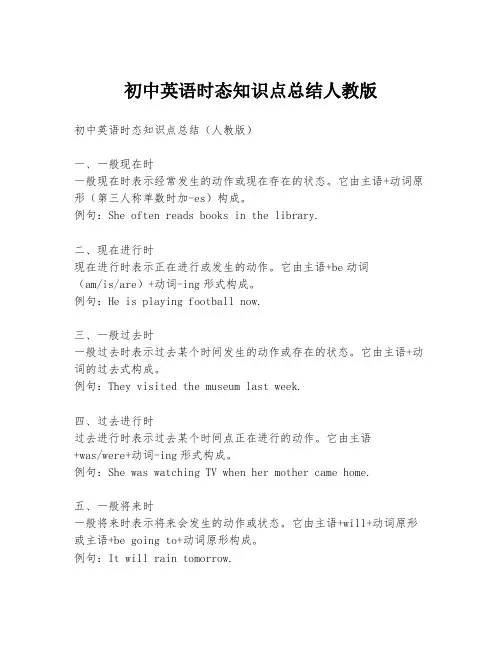
初中英语时态知识点总结人教版初中英语时态知识点总结(人教版)一、一般现在时一般现在时表示经常发生的动作或现在存在的状态。
它由主语+动词原形(第三人称单数时加-es)构成。
例句:She often reads books in the library.二、现在进行时现在进行时表示正在进行或发生的动作。
它由主语+be动词(am/is/are)+动词-ing形式构成。
例句:He is playing football now.三、一般过去时一般过去时表示过去某个时间发生的动作或存在的状态。
它由主语+动词的过去式构成。
例句:They visited the museum last week.四、过去进行时过去进行时表示过去某个时间点正在进行的动作。
它由主语+was/were+动词-ing形式构成。
例句:She was watching TV when her mother came home.五、一般将来时一般将来时表示将来会发生的动作或状态。
它由主语+will+动词原形或主语+be going to+动词原形构成。
例句:It will rain tomorrow.六、将来进行时将来进行时表示将来某个时间点正在进行的动作。
它由主语+will be+动词-ing形式构成。
例句:He will be working at this time tomorrow.七、现在完成时现在完成时表示过去发生的动作对现在造成的影响或结果,或者是从过去开始一直持续到现在的动作。
它由主语+have/has+动词的过去分词构成。
例句:I have finished my homework.八、现在完成进行时现在完成进行时表示从过去某一时间开始,一直持续到现在并可能继续下去的动作。
它由主语+have/has been+动词-ing形式构成。
例句:She has been studying English for five years.九、过去完成时过去完成时表示在过去某个时间点之前已经完成的动作。
初中现在进行时和过去进行时知识点和题(精心总结)复习进程
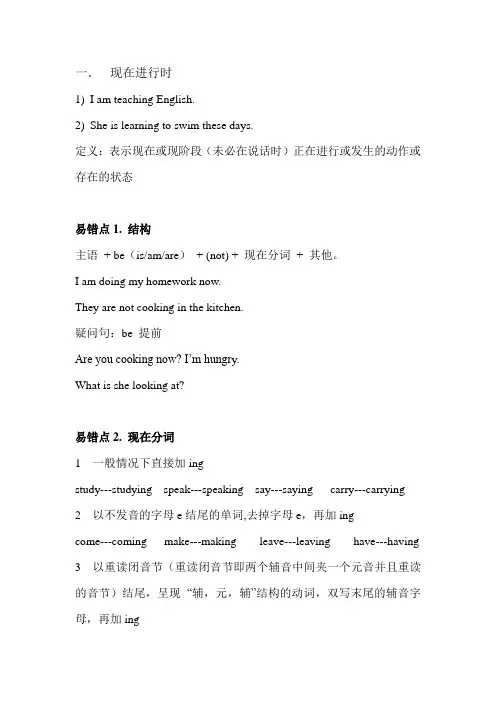
一.现在进行时1)I am teaching English.2)She is learning to swim these days.定义:表示现在或现阶段(未必在说话时)正在进行或发生的动作或存在的状态易错点1. 结构主语+ be(is/am/are)+ (not) + 现在分词+ 其他。
I am doing my homework now.They are not cooking in the kitchen.疑问句:be 提前Are you cooking now? I’m hungr y.What is she looking at?易错点2. 现在分词1 一般情况下直接加ingstudy---studying speak---speaking say---saying carry---carrying2 以不发音的字母e结尾的单词,去掉字母e,再加ingcome---coming make---making leave---leaving have---having 3 以重读闭音节(重读闭音节即两个辅音中间夹一个元音并且重读的音节)结尾,呈现“辅,元,辅”结构的动词,双写末尾的辅音字母,再加ingstop---stopping sit---sitting run---running forget---forgetting begin---beginning这类词还有:cut, get, hit, run, set, sit, spit, stop, swim, beg, drop, fit, nod, dig, forget, regret, rid, 等。
把ie改y再加ing4. die---dying tie---tying lie---lying易错点3. 时间状语时间类:now, at this moment, at present, in this month,these days情境类:Look! Listen! Be careful!Where is Tom? I can’t find him.Is there raincoat yours?eg: At the (this) moment, he is only weeping.Look! My mother is running!!!Listen! They are reading.Be careful! The car is running at you.---Where is Tom? I can’t find him.---He is playing games.---Is there raincoat yours?---Mine is hanging out here.易错点4.特殊用法与always, constantly, forvever 等词连用,表示反复发生的动作或存在的状态,往往带有说话人的主观色彩,讨厌,憎恨,惊讶,喜欢等You are always changing your mind.He is often playing the guitar. I can’t focus.现在进行时表将来, 马上,按计划将要发生的事情来来去去开始停止死come, arrive, go, leave, begin, start, stop, dieThe bus is coming.I’m going home in half an hour.我一个半小时内要回家。
初中英语八大时态归纳总结
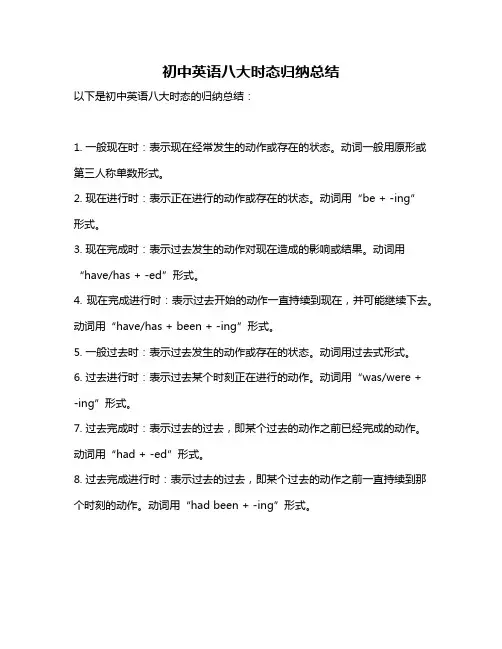
初中英语八大时态归纳总结
以下是初中英语八大时态的归纳总结:
1. 一般现在时:表示现在经常发生的动作或存在的状态。
动词一般用原形或第三人称单数形式。
2. 现在进行时:表示正在进行的动作或存在的状态。
动词用“be + -ing”
形式。
3. 现在完成时:表示过去发生的动作对现在造成的影响或结果。
动词用“have/has + -ed”形式。
4. 现在完成进行时:表示过去开始的动作一直持续到现在,并可能继续下去。
动词用“have/has + been + -ing”形式。
5. 一般过去时:表示过去发生的动作或存在的状态。
动词用过去式形式。
6. 过去进行时:表示过去某个时刻正在进行的动作。
动词用“was/were + -ing”形式。
7. 过去完成时:表示过去的过去,即某个过去的动作之前已经完成的动作。
动词用“had + -ed”形式。
8. 过去完成进行时:表示过去的过去,即某个过去的动作之前一直持续到那个时刻的动作。
动词用“had been + -ing”形式。
以上是初中英语的八大时态,理解和掌握这些时态对于英语学习和交流非常重要。
(完整版)一般现在时一般过去时现在进行时过去进行时归纳总结
(完整版)一般现在时一般过去时现在进行时过去进行时归纳总结一般现在时一般过去时现在进行时过去进行时1. 一般现在时(1)一般现在时的构成动词一般用原形,若主语为单数第三人称,则动词加词尾-s或-es,具体变化规则如下(与名词的单数变复数规则大致一样):1.一般情况下由动词后加-s构成。
如:work→works 工作read→reads 读look→looks 看come→comes 来live→lives 居住listen→listens 听2.以s, x, z, sh, ch 以及字母o结构的动词,后加-es。
如:guess→guesses 猜mix→mixes 混和go→goes 去finish→finishes 完成catch→catches 抓住3.以辅音字母加y结尾的动词,应将y改为i 再加-es。
如:fly→flies 飞行study→studies 学习carry→carries 带,扛一般现在时主要用动词的原形表示,如果主语是第三人称单数,则在动词原形式后加—s 或—es 。
如:Tom often helps his parents do housework at home.汤姆在家经常邦助父母做家务。
Sometimes Lucy washes her clothes herself.有时候露西亲自洗她的衣服。
(2)一般现在时的用法1)表示经常性或习惯性的动作或存在的状态。
与often , always ,usually , sometimes , once a week , every day 等表示频度的副词或时间状词连用。
如:I often go to school by bike. 我经常骑自行车去上学。
2) 表示客观事实或普遍真理。
如:The earth goes around the sun .地球绕着太阳转。
3)在时间、条件等状语从句中,用现在时表示将来。
如:If it rains tomorrow, we won’t go to the park.如果明天下雨,我们就不去公园了。
初中英语八种时态总结归纳
初中英语八种时态总结归纳一、一般现在时:概念:经常、反复发生的动作或行为及现在的某种状况。
时间状语:often,usually,always,sometimes,every week(day,year,month...),once a week,on sundays,etc.基本结构:①be动词;②行为动词否定形式:①am/is/are+not;②此时态的谓语动词若为行为动词,则在其前加don't,如主语为第三人称单数,则用doesn't,同时还原行为动词。
一般疑问句:①把be动词放于句首;②用助动词do提问,如主语为第三人称单数,则用does,同时,还原行为动词。
二、一般过去时:概念:过去某个时间里发生的动作或状态;过去习惯性、经常性的动作、行为。
时间状语:ago,yesterday,the day before yesterday,last week(year,night,month...),in 1989,just now,at the age of 5,one day,long long ago,once upon a time,etc.基本结构:①be动词;②行为动词否定形式:① was/were+not;②在行为动词前加didn't,同时还原行为动词。
一般疑问句:①was或were放在句首;②用助动词do的过去式did提问,同时还原行为动词。
三、现在进行时:概念:表示现阶段或说话时正在进行的动作及行为。
时间状语:now,at this time,these days,etc.基本结构:am/is/are+doing否定形式:am/is/are+not+doing一般疑问句:把be动词放在句首四、过去进行时:概念:表示过去某段时间或某一时刻正在发生或进行的行为或动作。
时间状语:at this time yesterday,at that time或以when引导的谓语动词是一般过去时的时间状语等。
初中英语语法八大时态总结及练习题
英语语法八大时态一.一般现在时结构肯定句式: 主语+动词原形/动词的第三人称单数+其他否定句式: 主语+(助动词)don't/doesn't +动词原形+其他一般疑问句式: Do/Does+主语+动词原形+其他简略回答: (肯)Yes,主语+do/does (否)No,主语+do/does not缩写形式: don't = do not doesn't = does not例句:He often goes swimming in summer.I usually leave home for school at 7 every morning.二.一般过去时态结构肯定句式: 主语+动词过去式+其他否定句式: 主语+(助动词)didn’t +动词原形+其他一般疑问句式: Did+主语+动词原形+其他基本结构否定句一般疑问句Be动词was/were+not was/were提前,放于句首行为动词didn’t+do(动词原形)Did+主语+do(动词原形)三.一般将来时结构结构1:肯定句式:主语+助动词will+动词原形+其他否定句式:主语+助动词will+动词原形+not+其他一般疑问句式:助动词Will+主语+动词原形+其他简单回答:在口语中,will在名词或代词后常缩为’ll,wii not常简缩为won’t。
在疑问句中,主语为第一人称时(I和we)时,常用助动词shall。
例如:She’ll go to play basketball.Shall we go to the zoo?结构2:肯定句式:主语+be going to +动词原形+其他否定句式:主语+be not going to +动词原形+其他一般疑问句式:Be+主语+going to+动词原形+其他简略回答:(肯)Yes,主语+be (否)No,主语+be not将来时其他表示法1)be going to表示将来表示说话人的打算、计划、安排或根据迹象判断必然或很可能发生的事情。
初中现在进行时和过去进行时知识点和题(精心总结)
初中现在进行时和过去进行时知识点和题(精心总结)-CAL-FENGHAI-(2020YEAR-YICAI)_JINGBIAN一.现在进行时1)I am teaching English.2)She is learning to swim these days.定义:表示现在或现阶段(未必在说话时)正在进行或发生的动作或存在的状态易错点1. 结构主语 + be(is/am/are) + (not) + 现在分词 + 其他。
I am doing my homework now.They are not cooking in the kitchen.疑问句:be 提前Are you cooking now I’m hungry.What is she looking at易错点2. 现在分词1 一般情况下直接加ingstudy---studying speak---speaking say---saying carry---carrying2 以不发音的字母e结尾的单词,去掉字母e,再加ingcome---coming make---making leave---leaving have---having3 以重读闭音节(重读闭音节即两个辅音中间夹一个元音并且重读的音节)结尾,呈现“辅,元,辅”结构的动词,双写末尾的辅音字母,再加ingstop---stopping sit---sitting run---running forget---forgetting begin---beginning这类词还有:cut, get, hit, run, set, sit, spit, stop, swim, beg, drop, fit, nod, dig, forget, regret, rid, 等。
把ie改y再加ing4. die---dying tie---tying lie---lying易错点3. 时间状语时间类:now, at this moment, at present, in this month,these days 情境类:Look! Listen! Be careful!Where is Tom I can’t find him.Is there raincoat yours?eg: At the (this) moment, he is only weeping.Look! My mother is running!!!Listen! They are reading.Be careful! The car is running at you.---Where is Tom I can’t find him.---He is playing games.---Is there raincoat yours?---Mine is hanging out here.易错点4.特殊用法与 always, constantly, forvever 等词连用,表示反复发生的动作或存在的状态,往往带有说话人的主观色彩,讨厌,憎恨,惊讶,喜欢等You are always changing your mind.He is often playing the guitar. I can’t focus.现在进行时表将来, 马上,按计划将要发生的事情来来去去开始停止死come, arrive, go, leave, begin, start, stop, dieThe bus is coming.I’m going home in half an hour.我一个半小时内要回家。
- 1、下载文档前请自行甄别文档内容的完整性,平台不提供额外的编辑、内容补充、找答案等附加服务。
- 2、"仅部分预览"的文档,不可在线预览部分如存在完整性等问题,可反馈申请退款(可完整预览的文档不适用该条件!)。
- 3、如文档侵犯您的权益,请联系客服反馈,我们会尽快为您处理(人工客服工作时间:9:00-18:30)。
一.现在进行时1)I am teaching English.2)She is learning to swim these days.定义:表示现在或现阶段(未必在说话时)正在进行或发生的动作或存在的状态易错点1. 结构主语 + be(is/am/are) + (not) + 现在分词 + 其他。
I am doing my homework now.They are not cooking in the kitchen.疑问句:be 提前Are you cooking now? I’m hungr y.What is she looking at?易错点2. 现在分词1 一般情况下直接加ingstudy---studying speak---speaking say---saying carry---carrying2 以不发音的字母e结尾的单词,去掉字母e,再加ingcome---coming make---making leave---leaving have---having3 以重读闭音节(重读闭音节即两个辅音中间夹一个元音并且重读的音节)结尾,呈现“辅,元,辅”结构的动词,双写末尾的辅音字母,再加ingstop---stopping sit---sitting run---running forget---forgetting begin---beginning这类词还有:cut, get, hit, run, set, sit, spit, stop, swim, beg, drop, fit, nod, dig, forget, regret, rid, 等。
把ie改y再加ing4. die---dying tie---tying lie---lying易错点3. 时间状语时间类:now, at this moment, at present, in this month,these days情境类:Look! Listen! Be careful!Where is Tom? I can’t find him.Is there raincoat yours?eg: At the (this) moment, he is only weeping.Look! My mother is running!!!Listen! They are reading.Be careful! The car is running at you.---Where is Tom? I can’t find him.---He is playing games.---Is there raincoat yours?---Mine is hanging out here.易错点4.特殊用法与 always, constantly, forvever 等词连用,表示反复发生的动作或存在的状态,往往带有说话人的主观色彩,讨厌,憎恨,惊讶,喜欢等You are always changing your mind.He is often playing the guitar. I can’t focus.现在进行时表将来, 马上,按计划将要发生的事情来来去去开始停止死come, arrive, go, leave, begin, start, stop, dieThe bus is coming.I’m going home in half an hour.我一个半小时内要回家。
练习:1. Who _____ over there now?A. singingB. are singC. is singingD. sing2. It’s eight o’clock. The students _____ an English class.A. haveB. havingC. is havingD. are having3. Listen! The baby _____ in the next room.A. cryingB. criedC. is cryingD. cries4. Look! The twins _____ new sweaters.A. are wearingB. wearingC. are wearD. is wearing5. Don’t talk here. Grandparents _____.A. is sleepingB. are sleepingC. sleepingD. sleep6. --- Hu rry up! We’re all waiting for you.--- I ______ for an important phone. Go without me.A. waitB. was waitingC. am waitingD. waited7. --- Is this your hat?--- No, mine ______ there behind the door.A. has hungB. is hangingC. hungD. will hang8.–When_____he_____back? –Sorry, I don’t know.A. does,comeB.are comingC.is c omeD.is coming六、过去进行时1) She was reading a book at 8 a.m. this morning.2) They are shopping from 8 to 9 last night.定义:表示过去某个时刻或过去某个阶段正在进行或发生的动作或存在的状态易错点1. 结构主语+ be ( was/were) + (not) + 动词现在分词 + 其他be 体现过去时态,doing 表示动作进行We were having a meeting this time yesterday.What were you doing when I called you?疑问句:was/were 提前易错点2. 常用时间状语,特殊用法this morning , the whole morning, all day yesterday, this time last night, from 2 to 4 yesterday,when, whileMy brother fell and hurt himself while he was riding his bike. she was making cakes when her mother arrived at home. When, while 都表示“当……时”的时候, while 后一般都是进行时态, when 后可加任何时态,但考试时候,多考when 后加一般时态,while 后加进行时态的辨析。
具体情况具体分析,还考情商1. She_________ apples in her garden when I_________ to see her yesterday. BA. picked,wentB. was picking,wentC. picked,was goingD. was picking,was going2. I ____ an old friend of mine when I ______ in the street yesterday afternoon . AA. met... was walkingB. was me eting ... walkedC. was meeting ... was walkingD. met ... walked3.While she ______ TV in the sitting room , the bel l ______ . CA. watches ,ringsB. is wat ching ,rangC. was watching ,rangD. watched ,was ringing4. The little girl was ______ her cat while her m other was _____ the piano . CA. playing ,playingB. playing ,playing withC. playing with ,playingD. playing with ,playing with2. 宾语从句,主过从过She said that she was sleeping at 8:00.练习:( )1. What _____ your grandfather _____ this ti me yesterday ?A. is ... doingB. was ... doingC. did .. doD. had ... done( )2. ____ you ______ a meeting at four yester day afternoon ?A. Were ... havingB. Was ... havingC. Di d ... haveD. Do ... have( )3. A: I called you at about half past eigh t last night , but nobody answered .B: Oh , I ______ in my office at that time .A. will workB. was workingC. worked D . had worked( )4. His family _____ TV from ten to twelve last night .A. watchedB. were watchingC. had watchedD. was watching( )5. A: Hi , Lin Tao . I didn’t see you a t the party .B: Oh, I ________ ready for the maths exam .A. am gettingB. was gettingC. gotD. have got( )6. A: I called you yesterday evening ,but t here was no answer.B: Oh ,I am sorry I ________ dinner at my frien d’s home.A.have B.had C.was having D.have had( )7. A: Did you notice him come in?B: No. I _____ a football game.A. have watchedB. had watchedC. am watc hingD. was watching( )8. You must tell us what you _______ at te n yesterday evening .A. didB. was doingC. were doneD. we re doing( )9. It was Friday evening. Mr and Mrs. Green _____ ready to fly to England.a. are gettingb. getc. were gettingd. got( )10. A: How did the accident happen ?B: You know , it ______ difficult to see the road clearly because it _____ .A. was , was rainingB. is , has rainedC. is, is rainingD. will be ,will rain( )11. One day when I _______ the post office , I _____ my uncle .A. pass... sayB. was passin g ... sawC. passed ... was seeingD. am passing .. . am seeing( )12. The student ______ to move the bag of rice _______ he heard the sound of a motorbike .A. was running... whenB. was running ... whileC. runs ... whenD. ran ... whil e( )13. Mark ________ while he ________ up and down.A. falls...is jumpingB. fell...was jumpingC. was falling...was jumpingD. felt...was jump ing( )14. He said he _____ to draw a plane on the blackboard at that time.a. triesb. triedc. was tryingd. will try( ) 15. His parents wanted to know how he _____ on with his new classmates.a. was gettingb. getsc. is gettingd. will get( )16. He asked _______ outside .A. who are singingB. who was singingC. who singing wasD. who is singing。
